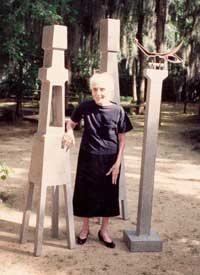Clyde Connell, 97, Sculptor Inspired by Louisiana Bayous
By Roberta Smith, THE NEW YORK TIMES
 Clyde Connell, who became a full-time artist only in her 60’s and who was known for totemic sculptures, imposing wall reliefs and runelike drawings, died on May 2 in a hospital in Shreveport, La. She was 97 and lived in Lake Bastineau in northwestern Louisiana.
Clyde Connell, who became a full-time artist only in her 60’s and who was known for totemic sculptures, imposing wall reliefs and runelike drawings, died on May 2 in a hospital in Shreveport, La. She was 97 and lived in Lake Bastineau in northwestern Louisiana.
Except for some traveling, Mrs. Connell spent her entire life within a 50-mile radius of Shreveport. She was striking even in old age, with white hair and a self-contained presence that sometimes drew comparisons with Georgia O’Keeffe.
Like O’Keeffe, she drew inspiration from the region in which she lived. She used brown earth and red clay to color her drawings and sculptures, as well as bits of iron scrap that her son, Brian, a cotton farmer, found in his fields. She had a mystical view of nature and described her drawings as transcriptions of its music, heard on the bayou.
Mrs. Connell, whose name had been Minnie Clyde Dixon, was born in 1901 and grew up on a large plantation, an experience that left her with a lifelong sympathy for black people in the South and an affinity for their culture.
She married Thomas Dixon Connell Jr. in 1922 and started taking art classes in Shreveport in the mid-1920”s. Some of her first serious paintings, made in the 1950’s after her children were grown, were Expressionist portraits of black prisoners on the penal farm where her husband was a superintendent.
A decisive moment in her life as an artist came in 1952, on a trip to New York City to do social work with the Presbyterian Church. She was drawn to the color and form of abstract art, especially the Abstract Expressionist paintings of Adolph Gottlieb, and made repeated visits to the Museum of Modern Art.
By the early 1960’s she had her first permanent studio and was working full time as an artist, keeping up with developments in contemporary art through reading and travel. In the late 60’s, after making assemblages of wood and iron held together by a mixture of paper and glue, she began to use this mixture as a building material, which she colored with dirt, reinforced with sticks and embedded with found metal.
The results, partly inspired by the work of Eva Hesse, were powerful objects, mostly tall and narrow, suggesting costumed shamans, decorated trees and towers. She produced them in series with evocative titles like ”Ritual Places,” ”Habitats,” ”Ladders” and ”Nests.” Another series, of enormous wall pieces, was titled ”Swamp Songs.”
Mrs. Connell’s work became increasingly known during the 1970’s, a time characterized by stylistic pluralism, the rise of feminism and increased attention to so-called regional artists. She had her first solo show outside Louisiana at the Tyler Museum in Tyler, Tex., in 1979, and her first New York show at the Delahunty Gallery in SoHo in 1984.
Her work is included in the collections of the Metropolitan Museum of Art, the New Orleans Museum of Art and the Laguna Gloria Art Museum in Austin, Tex. She has been represented since 1986 by the Arthur Roger Gallery in New Orleans, where she had a show of new work in October 1997.
In addition to her son, of Lake Bastineau, Mrs. Connell is survived by a sister, Anne Sewell of Boyce, La.; a brother, Louis Dixon of Baton Rouge, La.; a daughter, Clyde C. Ent of Allentown, Pa., 8 grandchildren and 10 great-grandchildren.
